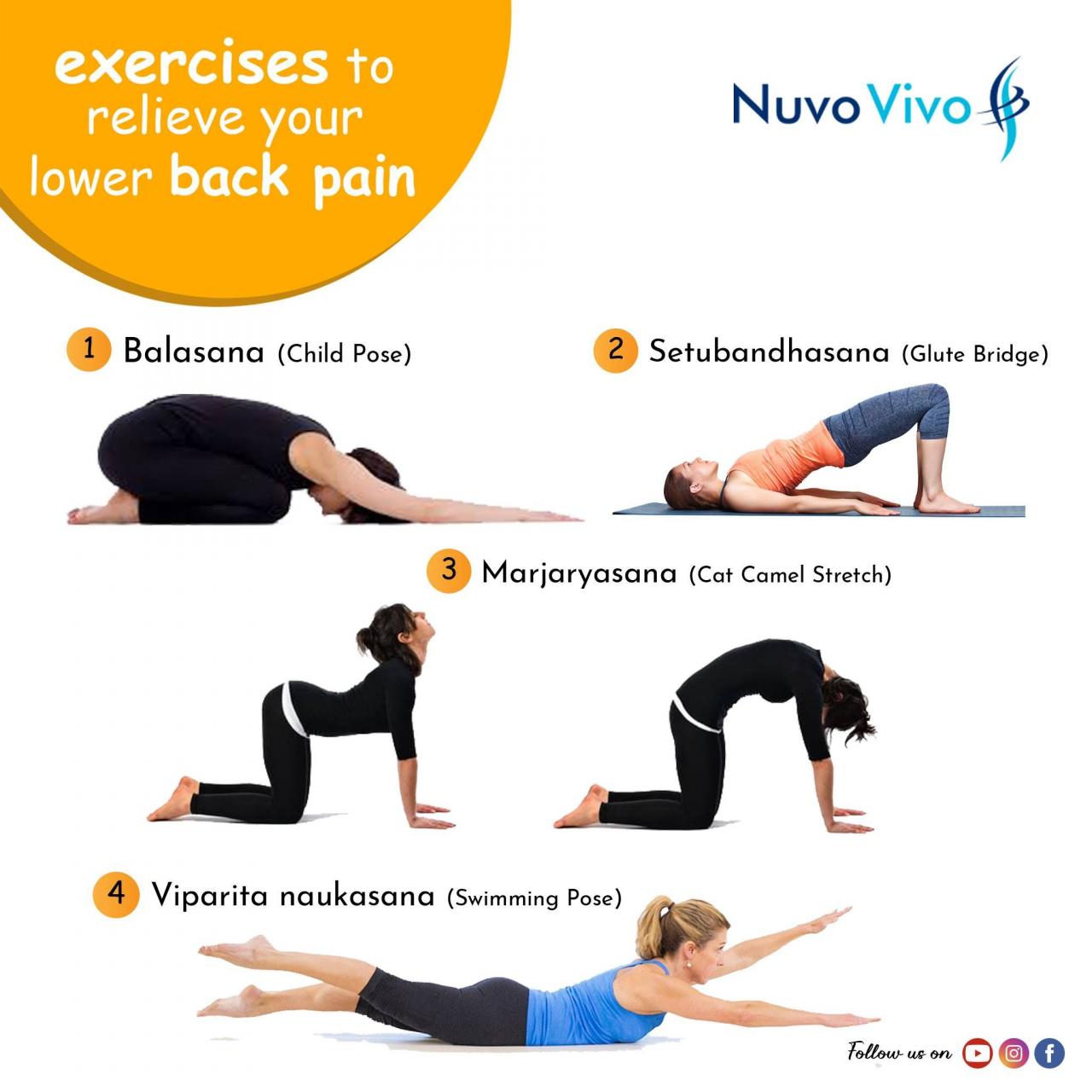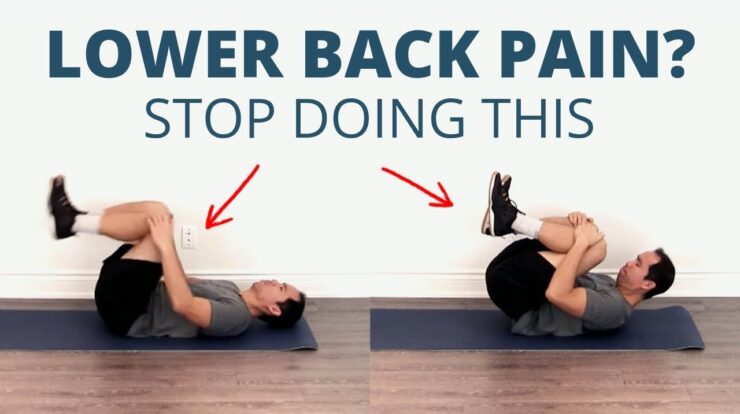
Exercises to relieve lower back pain offer a non-invasive approach to managing this common ailment. By strengthening core muscles, improving flexibility, and reducing inflammation, exercise can significantly alleviate pain and improve overall well-being.
This guide provides a comprehensive overview of exercises to relieve lower back pain, including specific exercises targeting different muscle groups, guidelines for frequency and duration, and precautions to consider. It also explores complementary therapies and patient education strategies to empower individuals in managing their lower back pain.
Lower Back Pain: Types, Benefits of Exercise, and Specific Exercises
Lower back pain is a common condition that affects millions of people worldwide. It can range from a mild ache to severe, debilitating pain that interferes with daily activities. Understanding the different types of lower back pain and the benefits of exercise can help individuals effectively manage this condition.
Types of Lower Back Pain

Lower back pain can be classified into three main types:* Acute pain:Sudden onset of pain that lasts for less than 3 months.
Chronic pain
Persistent pain that lasts for more than 3 months.
Radicular pain
Pain that radiates down the leg, often accompanied by numbness or tingling.Common causes of acute lower back pain include muscle strains, sprains, or a herniated disc. Chronic lower back pain may be caused by conditions such as osteoarthritis, spinal stenosis, or fibromyalgia.
Radicular pain is typically caused by nerve compression, such as from a herniated disc or bone spur.
Benefits of Exercise for Lower Back Pain

Regular exercise is an effective way to manage lower back pain by:* Strengthening back and core muscles to support the spine.
- Improving flexibility and range of motion.
- Reducing inflammation and pain.
- Improving posture and balance.
- Enhancing overall fitness and well-being.
Research has shown that exercise can significantly reduce lower back pain intensity and disability, and improve quality of life.
The importance of regular exercise in preventing flexibility issues cannot be overstated. As we age, our bodies naturally lose flexibility due to reduced physical activity and changes in muscle composition. However, by engaging in regular exercise, we can maintain and even improve our flexibility, reducing the risk of injuries and enhancing our overall quality of life.
Regular exercise helps keep our muscles supple, joints mobile, and bodies agile , allowing us to move with ease and grace throughout our lives.
Specific Exercises for Lower Back Pain: Exercises To Relieve Lower Back Pain
| Exercise | Description | How to Perform |
|---|---|---|
| Pelvic Tilts | Lie on your back with knees bent and feet flat on the floor. Tilt your pelvis upward, flattening your lower back. Hold for 5 seconds, then release. | |
| Cat-Cow Stretch | Start on hands and knees. Inhale, arching your back and lifting your head and tailbone. Exhale, rounding your back and tucking your chin to your chest. | |
| Knee-to-Chest Stretch | Lie on your back with knees bent. Pull one knee to your chest, holding for 30 seconds. Repeat with the other leg. | |
| Bird Dog | Start on hands and knees. Extend your right arm forward and your left leg backward simultaneously. Hold for 5 seconds, then switch sides. |
Exercise Frequency and Duration
The recommended frequency and duration of exercise for lower back pain management vary depending on individual needs and pain severity. Generally, it is recommended to start with short sessions of 10-15 minutes, 2-3 times per week. Gradually increase the duration and frequency as tolerated.
In the realm of health and wellness, regular exercise reigns supreme as the most effective means of preventing flexibility issues . By engaging in regular physical activity, individuals can enhance their range of motion, reduce muscle stiffness, and maintain optimal joint function.
Whether it’s through cardiovascular exercise, strength training, or flexibility exercises, regular movement helps keep muscles supple and agile, reducing the risk of developing flexibility limitations that can hinder daily life and overall well-being.
It is important to avoid overexertion and listen to your body.
Precautions and Contraindications
Before starting an exercise program for lower back pain, it is important to consult a healthcare professional to rule out any underlying medical conditions. Precautions should be taken for individuals with severe pain, nerve damage, or other health issues. It is essential to avoid exercises that aggravate pain or cause discomfort.
Complementary Therapies

In addition to exercise, complementary therapies such as heat therapy, massage, or acupuncture may enhance pain relief. Heat therapy can help relax muscles and reduce inflammation. Massage can improve circulation and relieve tension. Acupuncture may stimulate the body’s natural pain-relieving mechanisms.
However, it is important to discuss these therapies with a healthcare professional before use.
Patient Education and Empowerment
Patient education and empowerment are crucial for effective lower back pain management. Patients should be actively involved in their own care and understand the importance of exercise and other self-care strategies. Tips for Patients:* Learn about the different types of lower back pain and their causes.
As Mother’s Day approaches, Snoopy, the beloved beagle from the Peanuts comic strip, joins in the celebration with his signature cheerful demeanor . Snoopy’s endearing antics and heartwarming interactions with his human companion, Charlie Brown, have captured the hearts of generations.
On this special day dedicated to mothers, Snoopy’s presence brings a touch of joy and laughter, reminding us of the unwavering love and bond between mothers and their children.
- Engage in regular exercise and follow prescribed treatment plans.
- Listen to your body and avoid activities that aggravate pain.
- Maintain a healthy weight and avoid smoking.
- Manage stress and anxiety, which can contribute to pain.
- Seek professional help if pain persists or worsens.
Final Summary
Incorporating exercises to relieve lower back pain into a regular routine can effectively reduce pain, improve mobility, and enhance overall quality of life. By following the guidelines Artikeld in this guide, individuals can take an active role in managing their lower back pain and regaining a pain-free lifestyle.
General Inquiries
How often should I perform exercises to relieve lower back pain?
Aim for 2-3 sessions per week, gradually increasing frequency as pain improves.
Are there any exercises I should avoid with lower back pain?
Avoid exercises that involve twisting or bending forward at the waist, such as sit-ups or toe touches.
Understanding how stiff and tight muscles can result in back pain is essential for effective pain management. When muscles become tense and inflexible, they can put pressure on nerves and blood vessels, leading to pain and discomfort. Additionally, tight muscles can restrict movement, making it difficult to perform everyday activities.
Regular exercise and stretching can help alleviate muscle stiffness and tightness, reducing the risk of back pain and improving overall mobility.
Can I do exercises to relieve lower back pain if I have sciatica?
Maintaining strong back muscles is crucial for spinal health and preventing back pain. However, stiffness and tension in these muscles can contribute to discomfort and restricted movement. Regular exercise plays a vital role in preserving flexibility, as it helps keep muscles supple and reduces the risk of developing stiffness.
By incorporating regular physical activity into your routine, you can significantly reduce the likelihood of flexibility issues and maintain a healthy back.
Yes, but it’s important to consult with a healthcare professional first to ensure the exercises are appropriate for your condition.





